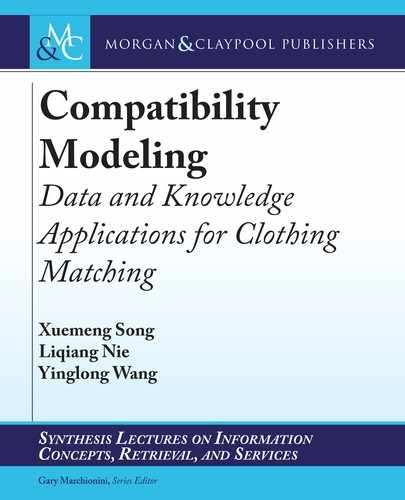
8 2. DATA COLLECTION
Table 2.1: Fashion item examples. “ >” indicates the category hierarchy.
ID Image Category Title
1
Women’s Fashion ->
Clothing ->Tops
River Island Resort
Light Blue Denim
Halter Neck Top
2
Women’s Fashion ->
Clothing
->Skirts -> Mini
Skirts
Plaid Ruffl ed Mini
Skirt
3
Women’s Fashion ->
Jeans -> Flared Jeans
MiH Jeans Mid-rise
Stretch-velvet Flares
Jeans
only 150 users, which hinders the practical evaluation. erefore, to bridge this gap, we created a
new large dataset for personalized clothing matching. In particular, we crawled our data from the
popular fashion web service IQON, where users are encouraged to create outfits by coordinating
fashion items from complementary categories (e.g., tops, bottoms, shoes, and accessories).
In particular, we first collected a set of popular outfits on IQON as the seeds, and by track-
ing them, we obtained 6,191 users. ereafter, we crawled the latest 500 historical outfits of each
user due to the following twofold concerns: (1) extremely active users have created thousands of
outfits, where according to our pilot study, the most active user has 4,562 outfits, which would
result in the imbalanced dataset and (2) users’ tastes on clothing matching may shift gradually
and it thus should be more reasonable to be reflected by their latest outfits. To ensure the qual-
ity of the dataset, we filtered out the users with less than 5 historical outfits and only retained
the items belonging to the six common categories: Coat, Top, Bottom, One Piece,
1
Shoes, and
Accessories. ereafter, we obtained 308,747 outfits created by 3,568 users with 672,335 fashion
items. e statistics of the dataset is listed in Table 2.2. For each fashion item, we particularly
crawled its profile, including the visual image, categories, attributes, and item description, as
shown in Figure 2.1.
1
One piece refers to the dress and tunic.

2.3. DATASET III FOR PERSONALIZED WARDROBE CREATION 9
Table 2.2: e number of items of each category
Category Number Category Number
Outerwear 35,765 Top 119,895
Bottom 77,813 Shoes 106.598
One Piece 25,816 Accessories 306,448
Figure 2.1: Screenshot of the item profile in IQON. We particularly collected the information
highlighted by the purple boxes. It is worth noting that the text has been translated here for
illustration.
2.3 DATASET III FOR PERSONALIZED WARDROBE
CREATION
In reality, it is hard to collect a comprehensive dataset that can well support the personalized
capsule wardrobe creation considering both the user modeling and garment modeling. erefore,
in this work, we employ different datasets in the user modeling and garment modeling. Polyvore
dataset [31], comprising 21,889 outfits with 164,379 fashion items involving corresponding
image and description, is adopted for the garment modeling.
As for the user modeling, although McAuley et al. [87] has introduced a public large-
scale Amazon dataset for personalized fashion recommendation tasks, it fails to incorporate the
..................Content has been hidden....................
You can't read the all page of ebook, please click here login for view all page.
